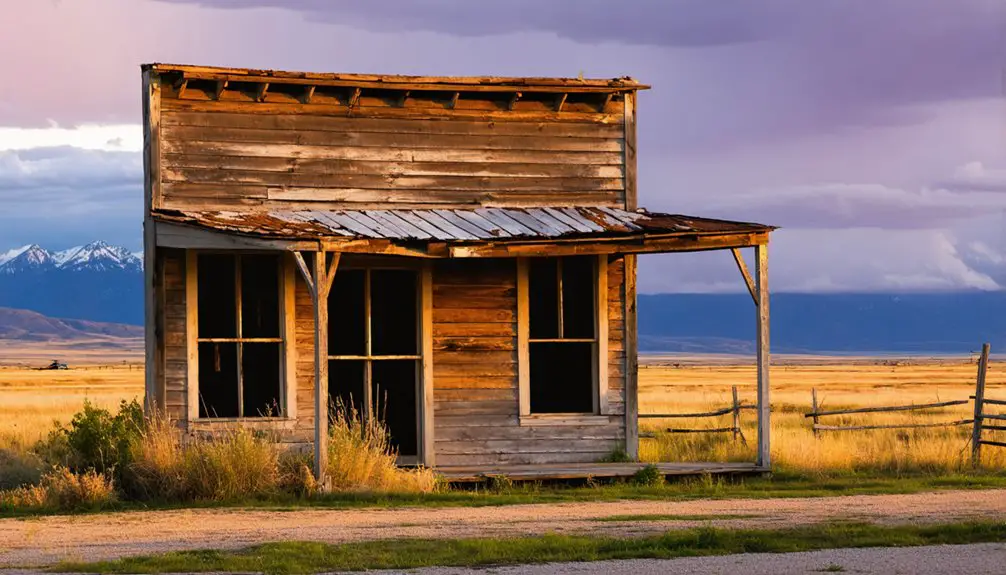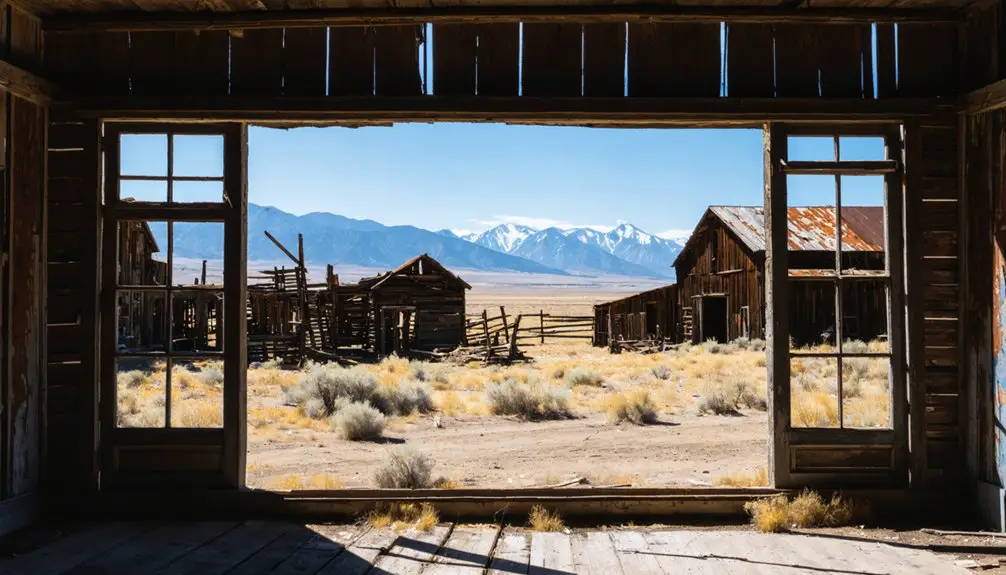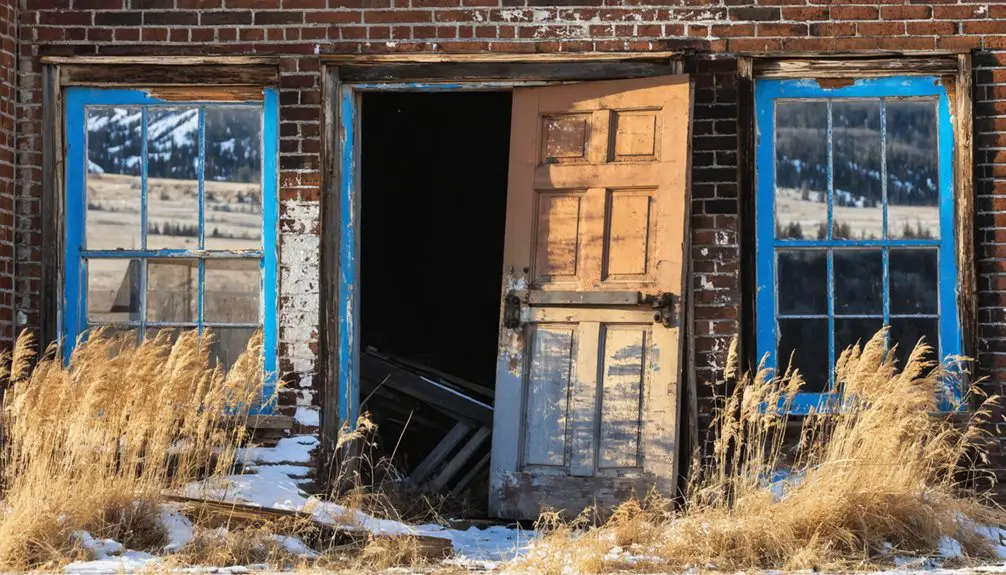You’ll discover Tower’s origins as Troutville before its 1875 renaming to honor financier Charlemagne Tower. This Montana silver mining settlement boasted a 10-stamp mill, twenty cabins, and bustling social venues like saloons and theaters. Though the 1893 Silver Panic challenged its prosperity, mining continued until 1968. Today, you can explore architectural remnants and preserved sites that tell the story of Montana’s frontier mining heritage.
Key Takeaways
- Originally named Troutville, Tower was renamed in 1875 to honor Charlemagne Tower, a prominent mining financier in Montana.
- The town flourished around silver mining operations until the 1893 Silver Panic, later rebounding with zinc and lead production until 1968.
- Mining life centered around exhausting 12-hour shifts, with workers facing dangerous conditions and limited access to medical care.
- Community life revolved around saloons, dancing halls, and theaters, with ethnic neighborhoods maintaining distinct cultural identities.
- Today, architectural remnants and foundations showcase Montana’s mining heritage, making Tower a destination for ghost town tourism.
Origins and Early Settlement
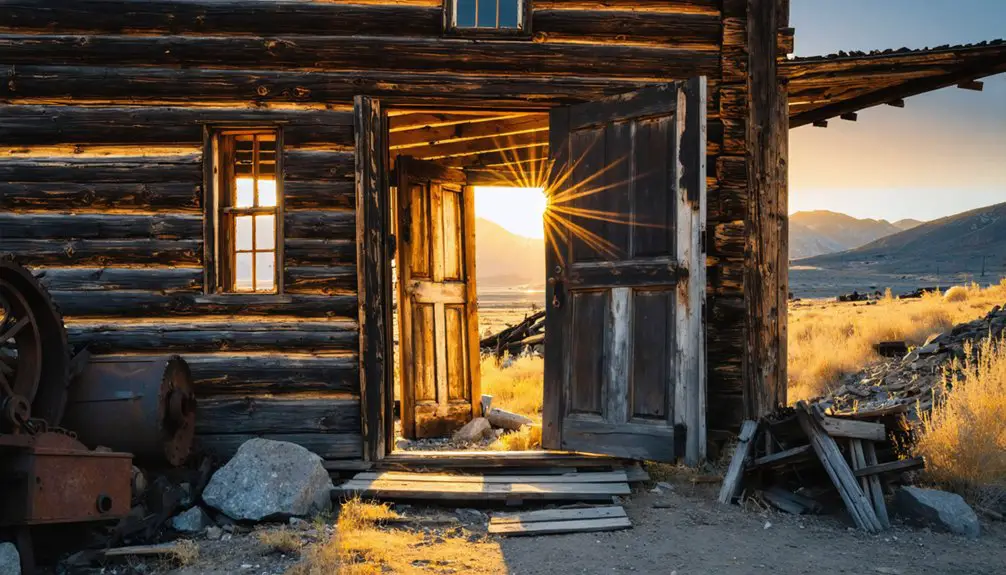
While silver discoveries drew prospectors to Montana’s mountainous regions, the settlement that would become Tower began as Troutville, named for the nearby Speckled Trout Lode. In 1875, you’d have witnessed the town’s renaming to honor Charlemagne Tower, a Michigan financier who’d become one of the key founding figures in the area’s development.
Tower, Pardee, Nettleton, and Ewing established the North-West Company to manage their mining interests, purchasing four mines and building a 10-stamp silver mill. Like many mining towns, Tower’s prosperity was short-lived due to the devastating Silver Panic of 1893. Mining operations provided steady work, with miners earning $3.50 daily during peak production periods.
Around this industrial hub, you’d have found about twenty cabins, a boarding house, and a storehouse – the basic infrastructure needed for the mining community. Known informally as Stumptown, the settlement’s layout and development were shaped by the surrounding silver deposits that drew people to this rugged mountain terrain.
Life in a Montana Mining Town
You’d have found life in Tower dominated by the relentless rhythm of mining shifts, where exhausted workers returned home to cramped quarters unable to tend to basic household needs.
The harsh realities of mining accidents, constant machinery noise, and environmental pollution shaped your daily existence in ways both subtle and profound. General stores, barber shops, and other businesses emerged to serve miners who lacked time for daily necessities. The extensive charcoal production required for smelting operations led to widespread deforestation of the surrounding landscape.
Despite these hardships, you could’ve found solace in the town’s social venues – from bustling saloons to theatrical performances – where the community gathered to briefly escape the grinding routine of mining life.
Daily Living Hardships
Life in Tower, Montana presented three major daily hardships that tested even the most resilient residents: dangerous mining work, inadequate housing, and limited access to essential services.
You’d have faced grueling 12-hour shifts underground, battling poor ventilation and constant risk of cave-ins. Your economic vulnerability meant you couldn’t miss work, even when facing serious health challenges from toxic gas exposure and dust inhalation. Much like the miners in Garnet who worked until the mines were declared dead in 1960, the demanding labor continued until resources were completely depleted.
At home, you’d return to a hastily constructed shelter that offered little protection from Montana’s harsh winters. Your family would huddle around wood stoves for warmth, while dealing with non-existent sanitation and unreliable water sources.
When accidents or illnesses struck, you’d find yourself hours away from proper medical care, relying instead on basic home remedies or the rare visiting doctor.
Mining Town Social Scene
Social life in Tower thrived despite the harsh realities of mining work, creating a vibrant tapestry of entertainment and community spaces.
You’d find multiple saloons serving as social gathering hubs, where miners could unwind after grueling shifts. Much like the nearby Garnet settlement with its thirteen saloons, Tower offered numerous drinking establishments to meet the social demands of its residents. The town’s entertainment venues offered diverse options for relaxation and cultural engagement. Similar to Fort Maginnis, the town employed skilled craftsmen who contributed to building the community’s infrastructure.
- Dancing halls and theaters hosted traveling troupes, bringing dramatic productions that transported you beyond the daily grind.
- Local entrepreneurs established barber shops, candy stores, and hotels, creating a bustling commercial district.
- Social halls and union meeting spaces fostered community activism and solidarity.
- Ethnic neighborhoods maintained strong cultural identities, with each group contributing to the town’s rich social fabric.
These community entertainment options helped residents cope with the demanding mining lifestyle while building lasting social bonds.
The Gold Rush Years
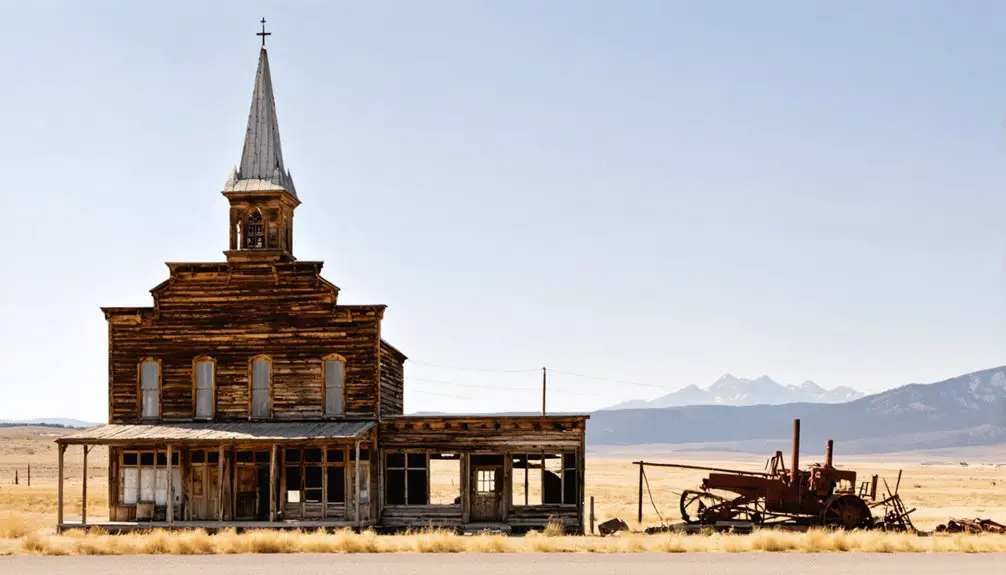
When gold was first discovered near Drummond in 1858 by Granville Stewart, James Stewart, and Reece Anderson, it sparked a transformative period in Montana’s history that would reshape the territory’s destiny.
You’ll find that the gold rush reached its zenith in the early 1860s, with major strikes at Grasshopper Creek, Alder Gulch, and Last Chance Gulch revolutionizing the region’s economy.
The mining techniques evolved rapidly during this period, as you’d witness prospectors moving from simple placer mining in riverbeds to more sophisticated lode mining operations. The earliest miners used basic hand tools and sluices to separate gold from dirt and gravel.
Within just three mining seasons, Alder Gulch alone yielded an astounding $30 million in gold.
This wealth creation led to Montana’s separation from Idaho Territory in 1864, establishing its own territorial identity and setting the stage for statehood in 1889.
Miners from the eastern United States and Europe made the arduous journey to Montana via the Missouri River to Benton.
Architecture and Infrastructure
Throughout Tower’s heyday, buildings sprang up using frontier construction methods that emphasized practicality over permanence. The town’s architectural preservation efforts reveal a fascinating glimpse into frontier life, where you’ll find structures built primarily with local logs and minimal foundations. The area’s development mirrored that of National Historic Landmark Bannack, featuring similar rugged construction styles.
Infrastructure challenges were common, as the town grew rapidly to support mining operations.
You’ll discover these distinctive features of Tower’s architecture and infrastructure:
- Log and frame buildings designed to be small and easy to heat during harsh Montana winters
- Essential structures including saloons, miners’ cabins, and stamp mills strategically placed throughout the settlement
- Unpaved streets lined with over 50 mixed-use buildings serving both residential and commercial needs
- Basic amenities like springs and creek runoff for water, with minimal municipal infrastructure
Mining Operations and Challenges
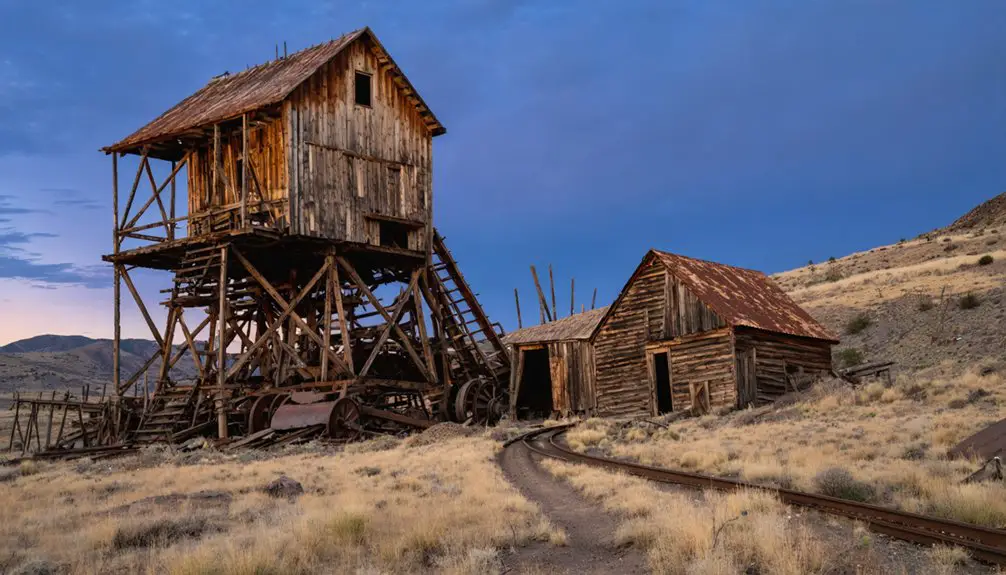
Mining operations in Tower began ambitiously with the discovery of the Speckled Trout Lode in 1888, leading to the establishment of the Iron Mountain Mining Company‘s primary extraction site.
You’ll find that mining challenges quickly emerged, including the mine’s forced closure in 1897 for lacking two required openings, and the devastating impact of the 1893 Sherman Silver Act repeal.
Despite setbacks, operations rebounded from 1909 to 1930, yielding impressive quantities of zinc, lead, and silver.
Technological advancements evolved from traditional underground methods to more efficient processes, including a 10-stamp silver mill.
However, persistent issues with declining ore grades and increasing extraction costs ultimately led to intermittent closures.
The final shutdown came in 1968, marking the end of Tower’s mining era despite various attempts to maintain profitable operations.
Daily Life and Social Scene
Life in Tower centered around a vibrant yet rugged social scene, where saloons and general stores served as the heart of community gatherings. You’d find miners congregating after their grueling shifts, sharing stories and news while seeking respite from their daily toils.
The town’s social gatherings thrived in several key locations where you could experience authentic community interaction:
- Union Hall and Fraternity Hall hosted heated political discussions and local affairs
- Kelly’s Saloon offered drinks, music, and laughter that echoed through the evening
- Local bunkhouses served as informal meeting spots where workers gathered to rest
- General stores doubled as social hubs where residents caught up on daily news
Despite the harsh frontier conditions, Tower’s residents maintained strong social bonds through these shared spaces, creating a tight-knit community amid the challenging mining life.
Legacy and Modern Remains
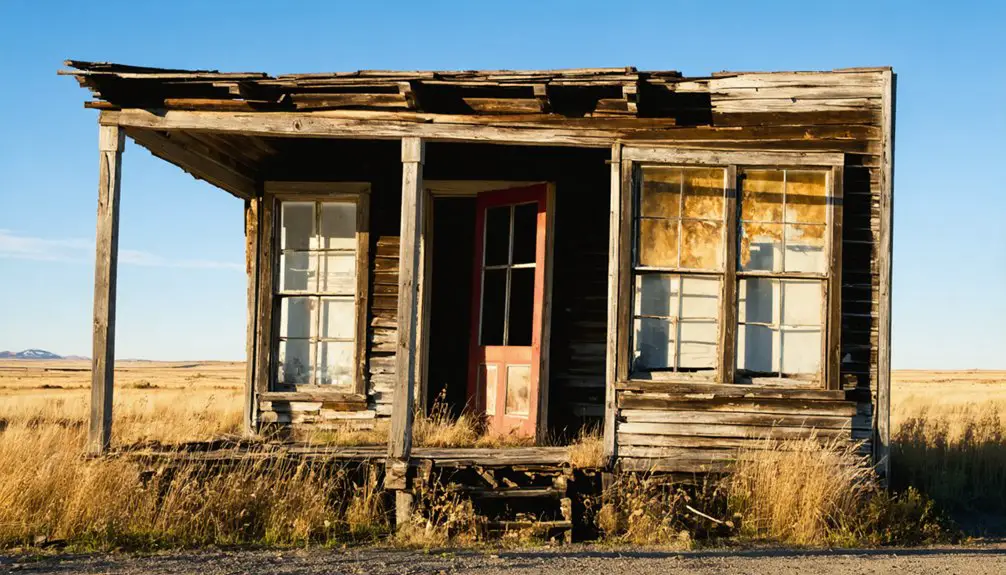
You’ll find Tower’s remaining foundations and partial structures tell a compelling story of Montana’s mining heritage, much like its better-known counterparts Bannack and Virginia City.
The architectural remnants, including mining infrastructure and hastily built structures, reflect the town’s quick rise and equally swift decline during the gold rush era.
While time has claimed many of Tower’s original buildings, its legacy endures through preserved sites, historical festivals, and educational programs that keep the region’s mining history alive for modern visitors.
Structural Traces Today
The enduring traces of Tower, Montana’s mining heritage stand evidence to frontier life through its remaining structures, though many have succumbed to time’s relentless march.
As you explore the site today, you’ll discover structural remnants typical of frontier mining settlements, with preservation efforts focused on maintaining the town’s historical authenticity.
- You can still identify the main street layout, where weathered buildings mark the original community hub.
- Several log and frame buildings remain standing, including remnants of the Miners’ Union Hall and company hospital.
- The town’s infrastructure reveals traces of saloons, dance halls, and commercial spaces, offering glimpses into daily frontier life.
- Protected under federal land management, interpretive signs guide you through the historical significance of surviving structures.
Historical Impact Endures
Although Tower’s mining operations ceased in 1968, its historical impact resonates through Montana’s cultural landscape as a tribute to the state’s silver mining heritage.
You’ll find Tower’s story woven into the broader tapestry of economic shifts that transformed the American West, from the boom years of silver mining through the World War I manganese surge.
The community’s resilience through changing federal policies and market demands exemplifies the adaptability of frontier mining towns.
Today, you can explore Tower’s legacy through ghost town tourism, where remnants of the 20 cabins, boarding house, and silver mill tell tales of community resilience.
As part of Montana’s network of historic mining sites, Tower continues to educate visitors about the essential role these settlements played in shaping the region’s industrial and social development.
Frequently Asked Questions
How Many Documented Deaths Occurred in Tower During Its Peak Mining Years?
Like searching your smartphone’s dead zones, you can’t find exact death counts for Tower’s peak years, though mining accidents and health epidemics surely claimed lives in this underreported Montana settlement.
Were There Any Notable Crimes or Outlaws Associated With Tower?
You won’t find specific outlaw legends tied directly to Tower, though nearby areas saw Wild Bunch gang activity and cattle rustlers. The region’s crime history includes vigilante justice and mining-related lawlessness.
What Native American Tribes Originally Inhabited the Tower Area?
Like eagles soaring over sacred peaks, the Lakota (Sioux), Kiowa, and Crow tribes claimed this land as their ancestral home, weaving their cultural heritage through stories of Bear Lodge’s creation.
Did Tower Have Any Connection to the Underground Railroad Movement?
You won’t find any underground connections or abolitionist activities in Tower’s history. Historical records show no evidence that Tower, far from established Underground Railroad routes, participated in the anti-slavery movement.
Were There Any Significant Natural Disasters That Affected Tower’s Development?
You won’t find evidence of natural disasters impacting Tower’s development – its decline was purely driven by economic factors like mining industry changes and market shifts in silver and manganese.
References
- https://www.garnetghosttown.org/history.php
- https://southwestmt.com/blog/ghost-town-terror-gunslinger-gulch/
- https://www.youtube.com/watch?v=YU0y9_5Ylbg
- https://www.mountain-home.com/blog/vacation-planning/guide-montana’s-ghost-towns
- https://www.youtube.com/watch?v=RKTDrpYtzRs
- https://www.mtghosttowns.com/tower
- https://getlostinamerica.com/montana-ghost-towns/
- https://avrextravel.com/montana-ghost-towns/
- https://www.legendsofamerica.com/mt-ghosttowns/
- https://montanakids.com/agriculture_and_business/mining/Early_days_of_Mining.htm
